Different kind of extinguishers for different types of fires.
7/20/2021 (Permalink)
Fires are some of the most devastating forces of nature a home, household, or business can face. Regardless, if a kitchen fire incident or falling asleep with a lit cigarette, your home or business can sustain serious damage. These happen to be some the most common fire damage types you will face in the U.S.
Class A
Involving solid combustible materials such as wood, paper, cloth, trash, or plastic, Class A fires are the most common types of fire. In addition to being the most common fire. To do so, it is recommended to use a water or foam fire extinguisher, or water to douse the fire.
Class B
Class B fires involve flammable and combustible liquids such as gasoline, alcohol, oil-based paints, lacquers. Therefore, extinguishers with a B rating are designed to extinguish fires involving flammable and combustible liquids.
Note: Do not attempt to extinguish a fire involving flammable gas unless there is reasonable assurance the source of fuel can be promptly shut off. In fact, if the only fuel burning is the leaking gas, the best method for extinguishing the fire is to shut off the fuel supply. Extinguishing a flammable gas fire, without shutting off the fuel, will allow unburned gas to escape into the atmosphere, which may permit a dangerous accumulation of gas to develop, and an explosion may occur if the gas is exposed to an ignition source.
Class C
Class C fires require a source of electricity. Therefore, they may be started by old wiring, worn-out breaker boxes, frayed electrical cords, or faulty appliances. Then, if possible, extinguish the flames using a carbon dioxide or dry powder fire extinguisher. Do not use water or foam to put out an electrical fire, as both materials can conduct electricity and potentially make the situation more dangerous.
Class D
Most rare among each class of fire, Class D fires can happen when metal ignites. This typically requires high levels of heat and is most common when alkali metals such as potassium, magnesium, aluminum, and sodium are exposed to air or water. Although you are unlikely to encounter a Class D blaze in your home, it is advised that such fires be extinguished with a dry powder extinguisher only.
Class E
Results from the factors found in both Class A and Class B fire damage. The difference being this class introduces electrical elements onto the list. This makes fighting the fire and the resulting damage vary from that in Class A and B.
Class F
A fire that results from the cooking of oils and fats. These fires are significantly hotter and pose more severe damage than those found in Class B.
Class K
Class K fires involve vegetable oils, animal oils, or fats in cooking appliances. Extinguishers with a K rating are designed to extinguish fires involving vegetable oils, animal oils, or fats utilized in commercial cooking appliances.
Note: Extinguishers with a K rating are normally required where deep-fryers and/or griddles are utilized to prepare large quantities of food. An example would be a commercial kitchen similar to those found in restaurants and cafeterias.






 24/7 Emergency Service
24/7 Emergency Service
